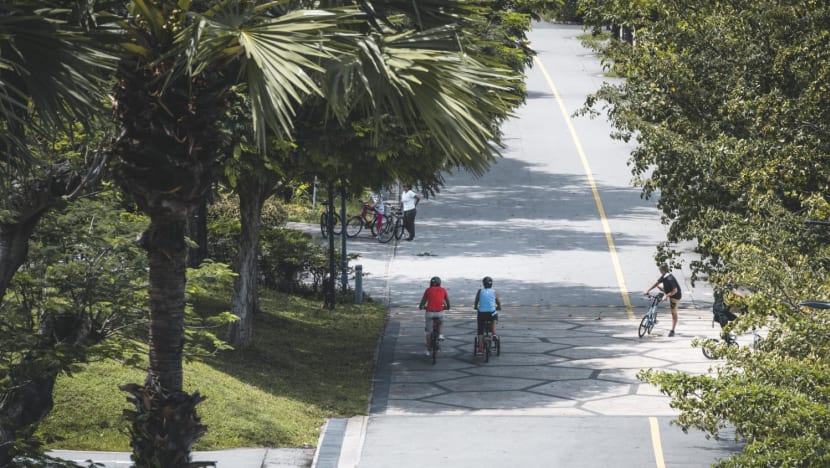Stay hydrated, avoid afternoons: Heat stress measures in place even before advisory, outdoor groups say
A new heat stress advisory service, launched in July, helps people gauge the risks of heat-related illnesses during outdoor activities.

Cyclists in Singapore. (File photo: iStock)
SINGAPORE: Organisations and outdoor activity groups said they already have measures in place to cope with hot weather, even before a new heat stress advisory service was introduced.
The service was launched in July to help people gauge heat stress risks during outdoor activities. It lists three levels of risk – low, moderate and high – in experiencing heat-related illnesses such as cramps, exhaustion and stroke.
The advisory does not apply to short-term outdoor movements, such as travelling to work or school, where there is lesser exposure to heat.
Cycling club TFRiders told CNA that it does not follow the advisory as its members start riding before sunrise and end by mid-morning, when it is cooler.
Cycling attire is also “highly breathable” and made of quick-dry material to wick perspiration and sweat away when riding, said Mr Tan Liang Cheng, who manages the club.
“The most important aspect in all of this is the need for consistent hydration and we make sure to do that on the go and as well as on mandated pit stops.”
Two football clubs told CNA they also take more water breaks in hot weather. One Singapore Premier League club, Albirex Niigata, only trains in the early mornings and evenings.
This ensures the “best balance” in dealing with the heat and considering players’ health and safety, said team manager Dominic Wong.
“Our coaches ensure that the players stay hydrated, providing sufficient cooling breaks during training to keep cool. Some players also use methods such as wetting down or rolling their sleeves to ensure that they remain as cool as possible in the sweltering heat,” he added.
Lion City Sailors Football School principal Rafael Palacios said he was confident that current measures are sufficient to ensure trainees' well-being.
The school has about 800 children and teenagers enrolled, with the youngest trainee being four years old.
Its heat stress measures include having sheltered areas on the pitch for water breaks and conducting training sessions for the youngest children at pitches near an air-conditioned dressing room so that they can get their rest indoors.
“While we are confident of the measures that we have already implemented, we will continue to monitor the situation going forward, and will definitely introduce additional measures to ensure our trainees remain safe and healthy even as they enjoy the sport and develop their game,” said Mr Rafael.
WORK INDOORS, SEND REMINDERS: COMPANIES
Two construction companies said they already have hot-weather measures in place, but they also take into account the new advisory service.
Hitomo Construction said it schedules indoor work activities when the heat risk is high. This is the same arrangement the company has for rain, which was in place even before the introduction of the heat stress advisory, said chief executive officer Serene Pan.
Workers may start earlier in the day when the temperature is cooler. They also get more water breaks and the company will provide drinks with electrolytes, said Ms Pan, adding that workers can also inform the site manager if they are feeling uncomfortable.
While heat is an “unavoidable factor” for construction projects, "workers' safety comes first", she said.
Similarly, United Tec Construction already had its own heat stress measures but after the advisory service was launched, it installed a temperature monitoring system and records temperatures at fixed periods, said senior corporate manager Eric Tan.
Employees working under direct sunlight will be rotated to minimise exposure. Work will be rescheduled as a “last resort”, added Mr Tan.
Delivery platforms said they send reminders to riders during periods of hot weather.
Grab uses in-app reminders to alert riders to the heat advisory risk, while foodpanda said it sends reminders regardless of the advisory, depending on weather conditions.
“Given that individuals’ heat tolerance varies, we will continue to send out reminders when the weather gets hot – and this can include days when the heat stress advisory is not issued,” said a spokesperson.
Deliveroo said it provides water for riders at its delivery-only kitchens and encourages merchants to offer drinks to riders in hot weather.
SCHOOLS, SAF ALIGNED WITH HEAT STRESS ADVISORY
Existing guidelines for schools are generally already aligned with the heat stress advisory, said the Ministry of Education (MOE).
The guidelines include minimising outdoor physical activities between 10.30am and 3.30pm, when heat and ultraviolet light levels are generally higher, said the Education Ministry in response to CNA queries.
“Schools also have the autonomy to determine the localised measures that can best help their students manage the heat, as weather and environmental conditions could vary across schools,” it said.
For example, schools can allow students to wear different uniforms. When the heat stress risk is high, schools can also conduct physical activities in sheltered or indoor spaces, implement more frequent breaks or reschedule activities to cooler parts of the day, said MOE in the statement.
The Singapore Armed Forces adopts heat injury prevention measures that take the heat acclimatisation level of servicemen, intensity of training and on-site medical support into consideration, said the Ministry of Defence.
The Ministry of Home Affairs, which oversees the Singapore Police Force and Singapore Civil Defence Force, said its measures to mitigate the risk of heat injuries are more detailed than the advisory.
Commanders and safety officers are also trained to recognise early signs of heat stress injury, and officers are also partnered up in a buddy system to look out for each other.
The Home Affairs Ministry adopts a five-band Wet-Bulb Globe Temperature (WBGT) work-rest cycle. This refers to the recommended duration of physical and rest time for officers, depending on the temperature.
For example, when the WBGT reaches 33 degrees Celsius or higher, the equivalent of a high risk of heat stress in NEA’s advisory, officers must have 30 minutes of rest for every 15 minutes of training, during which they will dress down by removing training equipment or external coverings.
When the WGBT exceeds 35 degrees Celsius, all strenuous activities must stop and officers must rest in indoor or sheltered environments, the ministry said.
ADVISORY A GUIDE FOR THE PUBLIC: MET SERVICE
In response to CNA’s queries about what was being done to encourage more people to use the heat stress advisory service, the Meteorological Service Singapore said it is a guide to help the public "make informed decisions" for prolonged outdoor activities.
Sectoral agencies have their own guidelines for managing heat stress, tailored to specific requirements such as students in school or workers at outdoor sites, added the Met Service, which is under the National Environment Agency (NEA).
Organisations and employees should refer to their respective heat stress guidelines where relevant.
“NEA will continue to educate the public on the use of the heat stress advisory to minimise the risk of heat-related illnesses,” said the Met Service.























